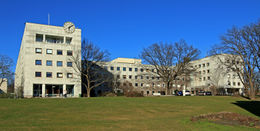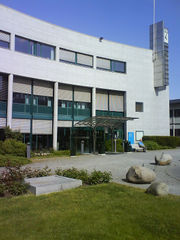Norwegian Broadcasting Corporation
 |
|
| Type | Publicly funded, public-service broadcaster |
|---|---|
| Industry | Broadcasting |
| Founded | 1924 / 1933 |
| Headquarters | Oslo, Norway |
| Key people | Hans Tore Bjerkaas |
| Products | TV, radio, online services |
| Employees | 3 481 (2004)[1] |
| Website | www.nrk.no |
The Norwegian Broadcasting Corporation (Norwegian: Norsk Rikskringkasting AS), which is usually known as the NRK, is the Norwegian government-owned radio and television public broadcasting company, and the largest media organisation in Norway. It is a founding member of the European Broadcasting Union.
Contents |
Financing
It is financed not as a post in the national budget, but primarily through a combination of a mandatory annual license fee for each person who is in possession of a TV (94 per cent), and a number of commercial activities such as programme and DVD sales, spin-off products and certain types of sponsorship.
History
Regular radio broadcasts started in Norway in 1925 by the privately owned company Kringkastningselskapet, the predecessor to NRK which was founded in 1933. Based on a model similar to the BBC, and located in Oslo, it was a replacement for privately operated radio stations in the larger cities. NRK initially set out to get coverage over the entire country, and had a monopoly on broadcasting in Norway until the monopoly was gradually dissolved from 1975 onwards.

During the World War II German occupation Norwegian transmitters were used for broadcasting German war propaganda to Northern Europe (particularly Scotland and the northern half of Ireland where the sea path ensured a good signal) and Scandinavia.
NRK was also partly financed by commercials on radio up until the German occupation.
NRK was one of 23 founding broadcasting organisations of the European Broadcasting Union in 1950. In 1954 NRK started broadcasting television shows on a trial basis, with regular broadcasts starting in 1960.
NRK was the last of the major European public broadcasters to introduce a second radio station, officially started as late as 1984. In 1993 NRK launched a third radio station, the youth-oriented P3. A 24-hour station for classical music, Alltid Klassisk, introduced in 1995, was the first of its kind to be broadcast digitally using DAB. The 24-hour news station Alltid Nyheter was then introduced in 1997, followed by a radio station for teenagers, mP3, in 2000, which mostly plays dance music continually.
In 1996, a second television channel, NRK2, was launched. The original television channel is now known as NRK1. September 3, 2007 NRK launched its third channel; The youth channel NRK3. Later that year, on December 1 NRK launched its fourth television channel, NRK Super, which is aimed at children. NRK3 and NRK Super shares the same channel, with NRK Super broadcasting from 0700 - 1900 and NRK3 from 1900 - 0700.
In 2004, a new radio station for traditional music, NRK Alltid folkemusikk was launched on DAB and internet radio.

The international radio transmissions from NRK, Utenlandssendingen, began transmissions on the shortwave bands in 1948. Initially broadcasting in Norwegian, English language programs were later added. The service was discontinued January 1, 2002. All NRK broadcasting activities on shortwave ceased on January 1, 2004. NRK's mediumwave transmitter at Kvitsøy on 1314 kHz used to be widely heard internationally and was one of the most commonly-heard trans-Atlantic DX signals in eastern North America. The frequency carried a mixture of NRK's radio channels P1 and P2, and was called Europakanalen. However, these mediumwave transmissions were discontinued on July 1, 2006.
All of the radio stations are now available on the internet. Several of the television programmes are also available on the internet.
NRK still holds the strongest position in number of viewers, though the competition from TV 2 is getting tougher.
NRK claims to have the longest running radio show, Lørdagsbarnetimen (lit. The Saturday Children's Hour), running since December 20, 1924.
In recent years, the network has shown itself to be the leading producer of original comedy shows in Norway, with such notable successes as Lillelørdag, Åpen Post, Uti Vår Hage and Team Antonsen, centered on a core of the comedians Harald Eia and Bård Tufte Johansen.
NRK has 12 regional offices spread around the country. All offices have their own broadcasts in both television and radio as well their own news sites on the internet. They also contribute daily with news coverage for the national news programmes. The two headquarters of NRK are located at Marienlyst in Oslo and Tyholt in Trondheim.

Organisation
A initiative for major organisational change was taken by the CEO in 2008 in order to create a more agile NRK, while still adhering to the principles of the broadcaster-producer model introduced in January 2001. By January 2009 the number of programme producing divisions had been reduced from five to three, separated more along geographical than functional lines, and at the same time simplifying trading in the internal market. The programme producing divisions are:
- Marienlyst covering all facilities in Oslo
- Distrikt, encompassing all regional offices and with their headquarters in Trondheim
- Sami, the producer of Sámi programmes situated in Karasjok
Since March 19, 2007 Hans-Tore Bjerkaas has been Director-General of the NRK.[2] Previous directors have been Olav Midttun (1934-1947, except during the Nazi occupation), Kaare Fostervoll (1948-1962), Hans Jacob Ustvedt (1962-1971), Torolf Elster (1972-1981), Bjartmar Gjerde (1981-1988), Einar Førde (1989-2001) and John G. Bernander (2001-2007).[3]
The chairman of the board is Hallvard Bakke (b. 1943). Bakke used to be a Norwegian politician for the Labour Party. He was the former Minister of Trade 1976-1979, and Minister of Culture 1986-1989. The current head (2006) of the news department is Gro Holm. Currently (2006) NRK employs between 3000 and 3500 people.
Notable television programmes
- Dagsrevyen
- Nytt på nytt
- Melodi Grand Prix (The Norwegian national selection for Eurovision Song Contest)
- The Eurovision Song Contest 1986, Eurovision Song Contest 1996, Eurovision Song Contest 2010 Grand Finals and the Eurovision Song Contest 2010 Semi-Finals
Channels
Radio
|
|
|
|
a Available on FM in only some parts of the country |
c In cooperation with Swedish SVT and Finnish YLE, |
Television
- NRK1
- NRK1 HD
- NRK2
- NRK3
- NRK Super
High-definition
NRK has an HD OB van, producing high-definition video.[4] The first Norwegian series filmed in HD is "En Udødelig Mann" (An Immortal Man) about the young Henrik Ibsen. The action "miniseries" (6 parts) called "Kodenavn Hunter" is also HD. Promo videos are freely downloadable from their site, and the full-length last episode is available [1]
NRK uses H.264 as the compression codec for the digital terrestrial network.
NRK has also started to offer HD content via BitTorrent. This is currently a very limited offer due to rights restrictions, but it's growing steadily.[5]
In preparation for the Winter Olympic Games in Vancouver, NRK announced that they would launch a high-definition channel, and their first native HD broadcast would be from Vancouver. NRK1 HD is a simulcast of NRK1.[6]
References
- ↑ Medienorge/Inst. for informasjon- og medievitenskap, Universitetet i Bergen
- ↑ Kringkastinggjef, 28 April 2009. Retrieved 2010-01-20.
- ↑ Kringkastingsjefene, 22 April 2009. Retrieved 2010-01-20.
- ↑ "Skandinavias mest avanserte" (HTML). Nordic Media Festival. http://www.mediedager.no/pub/pub_news.php?aID=294. Retrieved 2007-08-15.
- ↑ "NRKBeta - Bittorrent (Norwegian)" (HTML). Norwegian Broadcasting Corporation. http://nrkbeta.no/bittorrent/. Retrieved 2009-04-24.
- ↑ "NRK1 i HD fra 12. februar 2010 (Norwegian)" (HTML). http://nrkbeta.no/2010/01/14/hd-i-nrk/. Retrieved 2010-02-09.
See also
- List of programs broadcast by Norsk rikskringkasting
- yr.no
- List of Norwegian television channels
- List of Norwegian language radio stations
External links
|
||||||||
|
|||||||||||||||||||||||||||
|
|||||